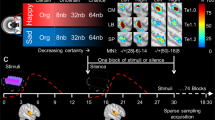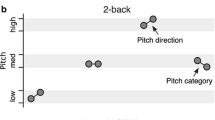Abstract
Sound timbre and sound volume processing are basic auditory discrimination processes relevant for human language abilities. Regarding lateralization effects, the prevailing hypotheses ascribe timbre processing to the right hemisphere (RH). Recent experiments also point to a role of the RH for volume discrimination. We investigated the relevance of the RH for timbre and volume processing, aiming at finding possible differences in cerebral representation of these acoustic parameters. Seventeen healthy subjects performed two auditory discrimination tasks on tone pairs, differing either in timbre or volume. FMRI was performed using an EPI-sequence on a 1.5 T scanner. Hemodynamic responses emerged in both tasks within a bilateral network of areas, including cingulate and cerebellum, peaking in primary and secondary auditory cortices (core and belt areas). Laterality analyses revealed a significant leftward dominance at the temporal cortex. Task comparison revealed significant activation within Broca’s area during the timbre task and a trend for an increase of right parietal responses during volume processing. These results contribute to a more differentiated view of timbre processing. Additionally to the engagement of the right temporal cortex during processing of musical timbre, there seem to be language related aspects of timbre that are preferentially processed in the left hemisphere. These findings are discussed within the framework of a model of timbre perception comprising two differentially lateralized subprocesses. Processing of spectral cues (harmonic structure) linked to the right hemisphere and processing of temporal cues (i.e. attack-decay dynamics) linked to the left hemisphere. Moreover, activation of Broca’s area linked to the timbre task indicates a participation of this area in discriminating phonetic changes of the vowel-like non-speech signals, encouraging the argument that basic acoustic cue processing at a pre- or non-speech level is represented within this “classical language area.”




Similar content being viewed by others
References
Ackermann, H., Mathiak, K., & Ivry, R. (2004). Temporal organization of “internal speech” as a basis for cerebellar modulation of cognitive functions. Behavioral and Cognitive Neuroscience Reviews, 3(1), 14–22.
Belin, P., McAdams, S., Smith, B., Savel, S., Thivard, L., Samson, S., et al (1998). The functional anatomy of sound intensity discrimination. Journal of Neuroscience, 18(16), 6388–6394.
Boucher, R., & Bryden, M. P. (1997). Laterality effects in the processing of melody and timbre. Neuropsychologia, 35(11), 1467–1473.
Brancucci, A., Babiloni, C., Rossini, P. M., & Romani, G. L. (2005). Right hemisphere specialization for intensity discrimination of musical and speech sounds. Neuropsychologia, 43(13), 1916–1923.
Brancucci, A., & San Martini, P. (2003). Hemispheric asymmetries in the perception of rapid (timbral) and slow (nontimbral) amplitude fluctuations of complex tones. Neuropsychology, 17(3), 451–457.
Burton, M., Small, S., & Blumstein, S. (2000). The role of segmentation in phonological processing: An fMRI investigation. Journal of Cognitive Neuroscience, 12(4), 679–690.
Bushara, K., Weeks, R., Ishii, K., Catalan, M., Tian, B., Rauschecker, J., et al. (1999). Modality-specific frontal and parietal areas for auditory and visual spatial localization in humans. Natural Neuroscience, 2(8), 759–766.
Deike, S., Gaschler-Markefski, B., Brechmann, A., & Scheich, H. (2004). Auditory stream segregation relying on timbre involves left auditory cortex. NeuroReport, 15(9), 1511–1515.
Dehaene-Lambertz, G. (2000). Cerebral specialization for speech and non-speech stimuli in infants. Journal of Cognitive Neuroscience, 12(3), 449–460.
Fiez, J., Raichle, M., Miezin, F., Petersen, S., Tallal, P., & Katz, W. (1995). PET studies of auditory and phonological processing: Effects of stimulus characteristics and task demands. Journal Cognitive Neuroscience, 7(3), 357–375.
Gandour, J., Wong, D., Lowe, M., Dzemidzic, M., Satthamnuwong, N., Tong, Y., et al. (2002). A cross-linguistic FMRI study of spectral and temporal cues underlying phonological processing. Journal of Cognitive Neuroscience, 14(7), 1076–1087.
Grey, J. (1977). Multidimensional perceptual scaling of musical timbres. Journal of the Acoustical Society America, 61, 1270–1277.
Grey, J. M., & Gordon, J. W. (1978). Perceptual effects of spectral modifications on musical timbres. Journal of the Acoustical Society America, 63, 1493–1500.
Halpern, R., Zatorre, R., Bouffard, M., & Johnson, J. (2004). Behavioral and neural correlates of perceived and imagined musical timbre. Neuropsychologia, 42(9), 1281–92.
Hartley, T., Trinkler, I., & Burgess, N. (2004). Geometric determinants of human spatial memory. Cognition, 94(1), 39–75.
Hauser, M., Chomsky, N., & Fitch, T. (2002). The faculty of language: What is it, who has it, and how did it evolve? Science, 298(5598), 1569–1579.
Heim, S., Opitz, B., Muller, K., & Friederici, A. D. (2003). Phonological processing during language production: fMRI evidence for a shared production-comprehension network. Brain Research Cognitive Brain Research, 16(2), 285–296.
Hertrich, I., & Ackermann, H. (1999). A vowel synthesizer based on formant sinusoids modulated by fundamental frequency. Journal of the Acoustical Society of America, 106, 2988–2990.
Hertrich, I., Mathiak, K., Lutzenberger, W., & Ackermann, H. (2003). Processing of dynamic aspects of speech and non-speech stimuli: A whole-head magnetoencephalography study. Brain Research Cognitive. Brain Research, 17(1), 130–139.
Hsieh, L., Gandour, J., Wong, D., & Hutchins, G. D. (2001). Functional heterogeneity of inferior frontal gyrus is shaped by linguistic experience. Brain Language, 76(3), 227–252.
Huang, J., Carr, T., & Cao, Y. (2002). Comparing cortical activations for silent and overt speech using event-related fMRI. Human Brain Mapping, 15(1), 39–53.
Iacoboni, M., Molnar-Szakacs, I., Gallese. V., Buccino, G., Mazziotta, J. C., & Rizzolatti, G. (2005). Grasping the intentions of others with one’s own mirror neuron system. PLoS Biology, 3(3), 79.
Iacoboni, M., Woods, R. P., Brass, M., Bekkering, H., Mazziotta, J. C., & Rizzolatti, G. (1999). Cortical mechanisms of human imitation. Science, 286(5449), 2526–2528.
Jäncke, L., Wüstenberg, T., Scheich, H., & Heinze, H. J. (2002). Phonetic perception and the temporal cortex. NeuroImage, 15(4), 733–746.
Jansen, A., Floel, A., Van Randenborgh, J., Konrad, C., Rotte, M., Forster, A., et al. (2005). Crossed cerebro-cerebellar language dominance. Human Brain Mapping, 24(3):165–172.
Joanisse, M., & Gati, J. (2003). Overlapping neural regions for processing rapid temporal cues in speech and nonspeech signals. Neuroimage, 19(1), 64–79.
Johnsrude, I., Zatorre, R., Milner, B., & Evans, A. (1997). Left hemisphere specialization for the processing of acoustic transients. NeuroReport, 8(7), 1761–1765.
Kimura, A., Donishi, T., Okamoto, K., & Tamai, Y. (2004). Efferent connections of “posterodorsal” auditory area in the rat cortex: Implications for auditory spatial processing. Neuroscience, 128(2), 399–419.
Koelsch, S., Gunter, T. C., v Cramon, D. Y., Zysset, S., Lohmann, G., & Friederici, A. D. (2002). Bach speaks: a cortical “language-network” serves the processing of music. Neuroimage, 17(2), 956–966.
Lasota, K., Ulmer, J., Firszt, J., Biswal, B., Daniels, D., & Prost, R. (2003). Intensity-dependent activation of the primary auditory cortex in functional magnetic resonance imaging. Journal of Computer Assisted Tomography, 27(2), 213–218.
Levitin, D., & Menon, V. (2003). Musical structure is processed in “language” areas of the brain: A possible role for Brodmann Area 47 in temporal coherence. Neuroimage, 20(4), 2142–2152.
Mathiak, K., Hertrich, I., Grodd, W., & Ackermann, H. (2002). Cerebellum and speech perception: A functional magnetic resonance imaging study. Journal of Cognitive Neuroscience, 14(6), 902–912.
Menon, V., Levitin, D., Smith, B., Lembke, A., Krasnow, B., Glazer, D., et al. (2002). Neural correlates of timbre change in harmonic sounds. NeuroImage, 17(4), 1742–1754.
Morosan, P., Rademacher, J., Schleicher, A., Amunts, K., Schormann, T., & Zilles, K. (2001). Human primary auditory cortex: Cytoarchitectonic subdivisions and mapping into a spatial reference system? NeuroImage, 13(4), 684–701.
Muller, R. A., Kleinhans, N., & Courchesne, E. (2001). Broca’s area and the discrimination of frequency transitions: A functional MRI study. Brain Language, 76(1), 70–76.
Mustovic, H., Scheffler, K., Di Salle, F., Esposito, F., Neuhoff, J. G., Hennig, J., et al. (2003). Temporal integration of sequential auditory events: Silent period in sound pattern activates human planum temporale. Neuroimage, 20(1), 429–434.
Oldfield, R. (1971). The assessment and analysis of handedness: The Edinburgh inventory. Neuropsychologia, 9, 97–113.
Opitz, B., Rinne, T., Mecklinger, A., von Cramon, D. Y., & Schroger, E. (2002). Differential contribution of frontal and temporal cortices to auditory change detection: fMRI and ERP results. Neuroimage, 15, 167–174.
Petacchi, A., Laird, A., Fox, P., & Bower, J. (2005). Cerebellum and auditory function: An ALE meta-analysis of functional neuroimaging studies. Human Brain Mapping, 25(1), 118–128.
Platel, H., Price, C., Baron, J. C., Wise, R., Lambert, J., Frackowiak, R. S., et al. (1997). The structural components of music perception. A functional anatomical study. Brain, 120(2), 229–243.
Price, C., Thierry, G., & Griffiths, T. (2005). Speech-specific auditory processing: Where is it? Trends in Cognitive Science, 9(6), 271–276.
Rauschecker, J., & Tian, B. (2000). Mechanisms and streams for processing of “what” and “where” in auditory cortex. Proceedings of the National Academy of Science of the United States of America, 97(22), 11800–11806.
Reiterer, S., Erb, M., Droll, C., Anders, S., Ethofer, T., Grodd, W., et al. (2005). Impact of task difficulty on lateralization of pitch and duration discrimination. Neuroreport, 16(3), 239–242.
Samson, S. (2003). Neuropsychological studies of musical timbre. Annals of the New York Acadademy of Science, 999, 144–151.
Samson, S., & Zatorre, R. (1994). Contribution of the right temporal lobe to musical timbre discrimination. Neuropsychologia, 32(2), 231–240.
Scott, S., & Johnsrude, I. (2003). The neuroanatomical and functional organization of speech perception. Trends in Neuroscience, 26(2), 100–107.
Shestakova, A., Brattico, E., Huotilainen, M., Galunov, V., Soloviev, A., Sams, M., et al. (2002). Abstract phoneme representations in the left temporal cortex: Magnetic mismatch negativity study. Neuroreport, 13(14), 1813–1816.
Thaut, M. H. (2003). Neural basis of rhythmic timing networks in the human brain. Annals of the New York Academy of Sciences, 999, 364–373.
Tzourio-Mazoyer, N., Landeau, B., Papathanassiou, D., Crivello, F., Etard, O., & Delcroix, N. (2002). Automated anatomical labelling of activations in spm using a macroscopic anatomical parcellation of the MNI MRI single subject brain. Neuroimage, 15, 273–289.
Vihla, M., & Salmelin, R. (2003). Hemispheric balance in processing attended and non-attended vowels and complex tones. Brain Research Cognitive Brain Research, 16(2), 167–173.
Warren, J., Jennings, A., & Griffiths, T. (2005). Analysis of the spectral envelope of sounds by the human brain. NeuroImage, 24, 1052–1057.
Warren, J., Zielinski, B., Green, G., Rauschecker, J., & Griffiths, T. (2002). Perception of sound-source motion by the human brain. Neuron, 34(1), 139–148.
Wilson, S. M., Saygin, A. P., Sereno, M. I., & Iacoboni, M. (2004). Listening to speech activates motor areas involved in speech production. Nature Neuroscience, 7(7), 701–702.
Zatorre, R., Belin, P., & Penhune, V. (2002). Structure and function of auditory cortex: Music and speech. Trends in Cognitive Science, 6, 37–46.
Acknowledgements
We thank I.Hertrich for valuable assistance in the generation process of the stimulus material, S. Anders and T. Ethofer for important discussions and comments as well as H.J.Mast for helpful assistance in data acquisition and recruitment of volunteers. This work was supported by the JUNG Stiftung for Wissenschaft und Forschung, Hamburg, Germany and the German Research Fundation (DFG WI 2101).
Author information
Authors and Affiliations
Corresponding author
Rights and permissions
About this article
Cite this article
Reiterer, S., Erb, M., Grodd, W. et al. Cerebral Processing of Timbre and Loudness: fMRI Evidence for a Contribution of Broca’s Area to Basic Auditory Discrimination. Brain Imaging and Behavior 2, 1–10 (2008). https://doi.org/10.1007/s11682-007-9010-3
Received:
Accepted:
Published:
Issue Date:
DOI: https://doi.org/10.1007/s11682-007-9010-3




